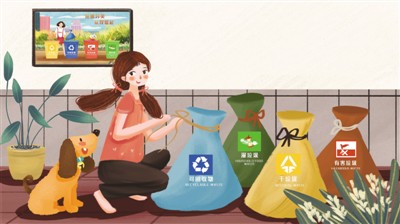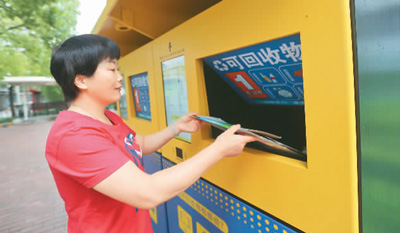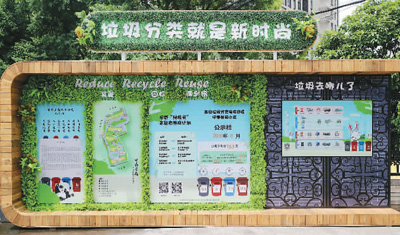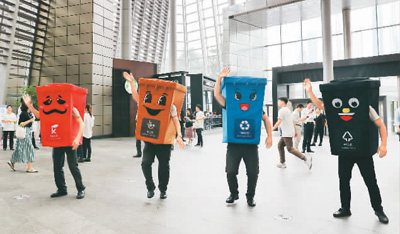

On July 1st, the Regulations of Shanghai Municipality on Domestic Waste Management was officially implemented. In Baoshan, Shanghai, citizens are using the "Love Recycling" intelligent sorting and recycling machine. Wang Chushe (People’s Vision)

On July 2nd, the publicity wall of garbage sorting in "Yu Tai Jingyuan" community of Jiaxing Road Street, Hongkou District, Shanghai. Xinhua News Agency reporter Fang Yushe

On June 19th, the property staff of Shanghai World Financial Center attracted people in the building to learn about garbage sorting through dancing. Xinhua News Agency reporter Liu Ying photo
Shanghai has implemented mandatory classification of domestic waste for half a month. Shanghai residents carefully study the knowledge of classification, while the managers of grass-roots community organizations try their best to find new ways to solve their problems and do a good job in garbage classification.
The reporter recently visited several communities in Xuhui District, the central city of Shanghai, to see what tricks are available for promotion.
Access cards act as supervisors.
Twelve villages in Tianlin are typical old-age housing communities in Shanghai, with more than 6,000 residents, nearly 1,400 over 60 years old, and the housing rental rate is close to 30%.
In the comprehensive management of the community in 2016, Twelve Villages in Tianlin realized the real-name registration of access cards for residential buildings, and became the first smart community platform in Tianlin Street in May 2018.
How to make the smart community platform a helper for household waste sorting? Neighborhood Committee cadres came up with a coup to "bind" the access card with the garbage room. Residents swiped their cards to throw garbage, and the management platform automatically registered the card swipers, opening time, card swiping times and green account points of the garbage room.
In view of the fear of throwing different garbage at several doors in rainy days and soiling hands with wet garbage, the community has carried out "six-in-one" hardware transformation for all garbage bins: configuring an access control system, installing an awning, installing an inductive sink, adding a set of cameras, a driving mirror and an electronic display screen.
A small camera is installed on the gate of the wet trash can with high garbage purity in the community, which is networked with the community management platform. At the same time, the wet garbage pickup truck of the sanitation department is also equipped with an induction probe. Once the wrong garbage is put in, the pickup personnel will find and inform the neighborhood Committee, retrieve the video data of the corresponding numbered trash can, and lock the residents who are not put in place. "No one comes to find the right one, and the wrong one can be traced back at any time", which greatly reduces the supervision cost.
The electronic screen on the garbage bin room instantly displays the data such as the total amount of garbage collected on that day and the separation rate of dry and wet garbage, so that residents can intuitively feel the effectiveness of garbage sorting.
After more than a year’s efforts, the "fixed-point" delivery rate of residents in Tianlin Twelve Villages reached 90%. On the basis of basic habits, from June this year, the street set a wrong time drop-off point in the southeast corner of the community to open access control "sub-cards" for some residents’ hourly workers and night shift workers to facilitate different people to drop garbage.
"We must strictly enforce hard constraints, but also fully consider the needs of residents and provide humanized services." Zhao Guoqing, secretary of the General Party Branch of Tianlin Twelve Villages Residential Area, said.
Alipay makes an appointment to recycle large pieces of garbage.
Open Alipay, enter the page of garbage sorting and recycling, click on "Booking for recycling of large pieces", select specific categories such as coffee tables and sofas, complete the payment price estimation according to the standards such as materials, disassembly, volume, service life, damage degree and floor condition, and then upload photos of large pieces to be recycled and specify the door-to-door time, and the order will be placed. This is the operation flow of the door-to-door recycling business platform for large-scale garbage in Hunan Road Street, Xuhui District, Shanghai.
Aunt Chen, who lives in Lane 55 of Wuyuan Road, has two pieces of furniture that have been idle for a long time. She has been unable to find a suitable way to deal with it. On WeChat group, she saw the notice about home recycling sent by the neighborhood Committee and tried it quickly. I didn’t expect the recycling master to come the next morning.
There are five members of the recycling and removal team, all of whom are "professionals" with many years of experience in garbage removal. They wear uniform blue overalls and drive vans. What is to be recycled is a wooden folding bed and a low table. As soon as he entered the door, the recycling team quickly took a photo of the bed and the table respectively. "You have to compare the photos first and take photos to leave a certificate." After the confirmation is completed, the recycling team starts the handling — — Two people are responsible for the folding bed, half open and walking sideways; The low table is carried by one person, and the long side stands up. The corridor in the old residential area is narrow and there is no elevator. Only by using the thinnest handling method can the furniture go downstairs smoothly. It takes less than five minutes to send the doorway from the fifth floor to load it into the truck. Master Sa, who led the team, said that the recycled large pieces of furniture will be sent to the designated recycling point for classification, and the good quality will enter the recycling link, and the poor quality will be treated in a centralized and standardized manner according to the construction waste standards.
Aunt Chen paid less than 50 yuan’s freight for these two pieces of old furniture, which she thought was reasonable. "A few years ago, I handled an old sofa myself, and it took more than half an hour to move the sofa down from the fifth floor."
Dong Wei, secretary of the Party Working Committee of Hunan Road Sub-district Office, said that there are many traditional lanes in Shanghai, and the living area is small, and the waste furniture still occupies the place. Residents have a great demand for recycling large pieces of garbage. "From the perspective of urban management, the recycling of large-scale garbage cannot rely on ‘ Guerrilla ’ 。” The street is connected with Alipay platform and recycling and clearing team, the price standard is set with reference to the market level, and the operation page is optimized to facilitate residents to place orders quickly, which not only solves the needs of residents, but also reduces the phenomenon of littering.
The recycling bin returns to the city center.
Recently, a green hut appeared at No.37, Donghu Road, Hengfu Scenic Area, one of the "noble lots" in Shanghai — — "Indus resource space". This is another innovation in garbage sorting in Hunan streets: a resource recycling station combining intelligent trading with manual trading.
"Collect scrap metal, waste plastics and waste newspapers … …” Whenever the bell rings in the alley, the residents of the community come out to sell waste products. This is a scene that many Shanghai residents remember. Nowadays, there are fewer and fewer people selling waste products in the streets, and there is no place for daily waste products to be left at home.
Hunan street came up with the idea of returning the "upgraded" waste recycling station to residential areas. The "Indus Resource Space" covers an area of nearly 20 square meters and is located at the intersection of five roads, namely Donghu Road, Xinle Road, Changle Road, Fumin Road and Yanqing Road, which can radiate many surrounding communities.
The LCD screen at the entrance of the recycling hut shows the prices of various recycled items such as glass, metal, plastic, paper and fabric. Recyclable items sent by residents and enterprises will automatically print out information such as weight and amount after being weighed by staff. The concentrated waste products are collected by professional resource recycling enterprises on a regular basis.
On the way to the stadium for exercise, Aunt Wang conveniently carried several cartons that had been flattened and packed. "The recycling price of cartons here is 4 cents more than that sold to scavengers per kilogram of 1.2 yuan. I have been here twice. "
"Indus Resource Space" is open regularly every Monday to Saturday. What should office workers do if they miss the opening hours? "Wutong Resource Space" has set up a 24-hour intelligent self-help exchange speculation at the gate. Residents use the mobile APP to scan the code to open the door of the corresponding category. After completing the transaction, they will automatically return the account to the mobile phone.
Kitchen garbage does not leave the community.
Wet garbage accounts for 60% of the total domestic garbage in Shanghai, and the transfer process is easy to cause secondary pollution to the environment, which is the difficulty of garbage disposal. On June 25th, the Citizen Environmental Protection Experience Center of Hongmei Street in Xuhui District was opened to explore a new mode of wet waste treatment, which is "kitchen waste does not leave the community". Hongmei Street has jurisdiction over 22 residential quarters with about 30,000 community residents. There are 3,000 enterprises and about 280,000 white-collar workers in caohejing Development Zone. Streets began to promote garbage sorting in 2016. By improving the hardware transformation of garbage bins, putting wet garbage in fixed time, "broken bags", on-site demonstration and supervision by volunteers, redemption of points and other supporting measures, residents gradually developed the habit of garbage source sorting and became one of the 18 demonstration streets of domestic garbage sorting in Shanghai.
Hongmei Street and Eco-tech Enterprises within its jurisdiction — — Tianwei Environmental Protection cooperated hand in hand to transport the wet garbage from residents’ living quarters and the kitchen garbage from enterprises in the development zone to the nearest citizen environmental protection experience center and three other centralized disposal points, and then put it into special equipment for about 15 minutes, so as to separate out reclaimed water, oil that can be used for biodiesel processing, and compost raw materials rich in biological strains.
The key to realize effective biological treatment of wet garbage is that the purity of wet garbage must reach more than 90%, that is, the doping degree of other garbage in a bucket of wet garbage should not be higher than 10%. Hongmei Street specializes in the whole process of wet garbage from delivery, removal to final disposal. At present, the street handles nearly 25 tons of kitchen waste every day, which improves the garbage infiltration pollution caused by long-distance transportation and transit, reduces the removal cost and improves the efficiency of resource localization.
Hongmei Street Citizen’s Environmental Experience Center covers an area of 350 square meters. The architectural design is characterized by the unique brick and wood structure with overhangs, the cloister of pond water and the cultivation of various plants, which embodies the concept of symbiosis between man and nature. Here, citizens can visit the whole process of kitchen waste from classification, centralized treatment to resource utilization.
Pu Yapeng, secretary of the Party Working Committee of Hongmei Street, said that "kitchen waste does not leave the community" not only requires effective management methods, but also innovates the removal process. "Data can best reflect the results of garbage classification". Every day, the street counts the removal amount of dry and wet garbage, detects the purity of wet garbage, and promotes management efficiency through quantitative management. "